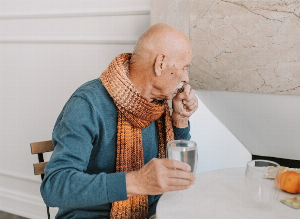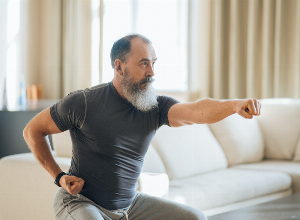Breathing Exercises for People with COPD
Published Apr 10, 2018

Chronic obstructive pulmonary disease is a disorder of the lungs that makes it difficult to breathe. Its main cause is smoking, but it can also be caused by exposure to pollution, fumes, or other irritating substances.
The condition has no cure, and it is the third leading cause of death in the United States.
Contents of this article:
- COPD and pulmonary rehab
- Pursed-lip breathing for COPD
- Diaphragmatic breathing (belly breathing)
- Activities that help COPD
COPD and pulmonary rehab
Chronic obstructive pulmonary disease (COPD) is usually a combination of two conditions: emphysema and chronic bronchitis.
Pulmonary rehab may include tailored exercise and fitness as well as breathing exercises.
In emphysema, tiny air sacks in the lungs can collapse, become stretched out, or be destroyed, resulting in problems with gas exchange in the lungs.
The lungs may not be able to get as much oxygen as they should, so a person with emphysema may feel out of breath while exercising, or even at rest. They may also experience a long-term cough that does not go away.
Chronic bronchitis, the other part of COPD, is associated with inflammation in the lungs' airways. As the airways are always inflamed, they produce mucus and can become clogged.
This makes it more difficult for the lungs to move air in and out. It often causes a feeling of breathlessness, tightness in the chest, and a chronic or long-term cough that produces mucus.
Many people with COPD find that even light activity can make them feel out of breath, and it may feel harder to breathe as time goes on. This can lead to a cycle of becoming less active and feeling increasingly breathless with reduced activity.
How pulmonary rehab can help
Pulmonary rehab is a program for people with breathing problems such as COPD. It is often done in a hospital or clinic. The patient works with a pulmonary rehab team, which may include doctors, nurses, pulmonary therapists, and other healthcare providers.
Pulmonary rehab aims to help a person improve their well-being and quality of life. It may include:
- Exercise and fitness training tailored for the patient's needs and breathing ability
- Diet and nutrition counseling
- Education about COPD and ways to manage it
- Counseling and support
- Breathing exercises
COPD cannot be reversed, but pulmonary rehab can help the lungs work better.
Pursed-lip breathing for COPD
While breathing exercises are a part of pulmonary rehab, they can also be done at home or whenever a person feels short of breath.
This can help to avoid quick breathing and panic when short of breath. Done regularly, proper breathing exercises can help the lungs to get rid of old, nonoxygenated air so they can take in fresh, oxygen-rich air more efficiently.
Pursed-lip breathing is one of the most popular breathing exercises for people with COPD. With regular practice, this exercise can help to slow down breathing and therefore get more air in and out of the lungs.
It improves the lungs' ability to get oxygen in and carbon dioxide out. A study published in American Family Physician found that it improves a person's ability to exercise with COPD.
To practice this exercise, a person should:
- Sit down in a comfortable spot
- Relax the neck and shoulders
- Breathe in slowly through the nose while keeping mouth closed
- Pucker or purse the lips, pretending to whistle or blow out a candle
- Breathe out all of the air in the lungs, slowly and gently, through the pursed lips
- The goal is to make the breathing out longer than the breathing in
Pursed-lip breathing may require practice and concentration. It should be practiced for 5 to 10 minutes each day. It is best to try it for the first time when a person is breathing normally.
Over time, pursed-lip breathing may help people with COPD to become more active and able to breathe easier.
Diaphragmatic breathing (belly breathing)
Diaphragmatic breathing, or belly breathing, helps a person use their diaphragm to support their breath.
The diaphragm is a muscle in the belly that helps to inflate the lungs.
People with COPD may use their diaphragm less and use their back and shoulders more. This makes their breathing weaker.
Diaphragmatic breathing can help a person to focus on using their diaphragm again.
To practice diaphragmatic breathing, a person should:
- Diaphragmatic breathing may help with COPD by focusing on the diaphragm which can help to inflate the lungs.
- Sit or lie down in a comfortable place and put their hands on their belly
- Relax the muscles in their neck and shoulders
- Breathe in slowly through the nose, keeping their mouth closed
- Feel the lungs fill with air and inflate like a balloon while their belly moves outward
- Slowly breathe out through pursed lips
- Let the air out gently, trying to make it last longer than the inhale
- Repeat for 5 to 10 minutes and concentrate on the belly going up and down each time
- Gently press on the belly while breathing out to encourage the diaphragm to move
Activities that help COPD
Some unrelated exercises and activities have also shown promise in medical studies as ways to improve quality of life for COPD patients.
Singing classes
A study in BMC Pulmonary Medicine found that people who took singing classes for 8 weeks fared better than their peers, who instead took a film class.
The singing group showed an improvement in physical well-being by the end of the study.
Although the exact reason for the improvement is unknown, the authors suggest that singing classes may be a useful activity for people with COPD, in combination with medical treatment.
Though specific improvements to breathing were not identified in the study, singing often involves diaphragmatic breathing. As a result, it may be an effective complement to pulmonary rehab and pursed-lip breathing.
Yoga
Yoga may help with deep breathing and relaxation.
The deep breathing and specific postures practiced in yoga can help with relaxation, flexibility, and mind-body wellness.
A study in the Journal of Thoracic Disease suggests that yoga may help people with COPD to improve lung function and their ability to exercise. Because there are more than 100 different forms of yoga, it is important to choose one that is safe and appropriate for a person's health and ability.
Tai Chi
Tai Chi is an ancient Chinese form of martial art that focuses on gentle exercise, stretching, meditation, and mindfulness.
A study in the Journal of Physiotherapy found that Sun-style Tai Chi improved walking performance and quality of life in people with COPD. The other types of Tai Chi have not been studied, though they are considered safe for most people due to their low impact and health benefits.
Lifestyle tips for better breathing
Because COPD causes poor lung function as well as weakened respiratory muscles, it is important to take care of the respiratory tract with healthy lifestyle choices.
In addition to medical care, people with COPD should:
- Stop smoking and avoid secondhand cigarette smoke
- Avoid dust, fumes, and chemicals
- Practice good hand washing
- Get a flu shot and other vaccines
- Avoiding crowds during cold and flu season
- COPD can be managed with proper medical care, pulmonary rehabilitation, breathing exercises, and lifestyle changes.
Together, these measures can help many people to become more active and feel better.
Medical News Today

 Facebook
Facebook Twitter
Twitter



